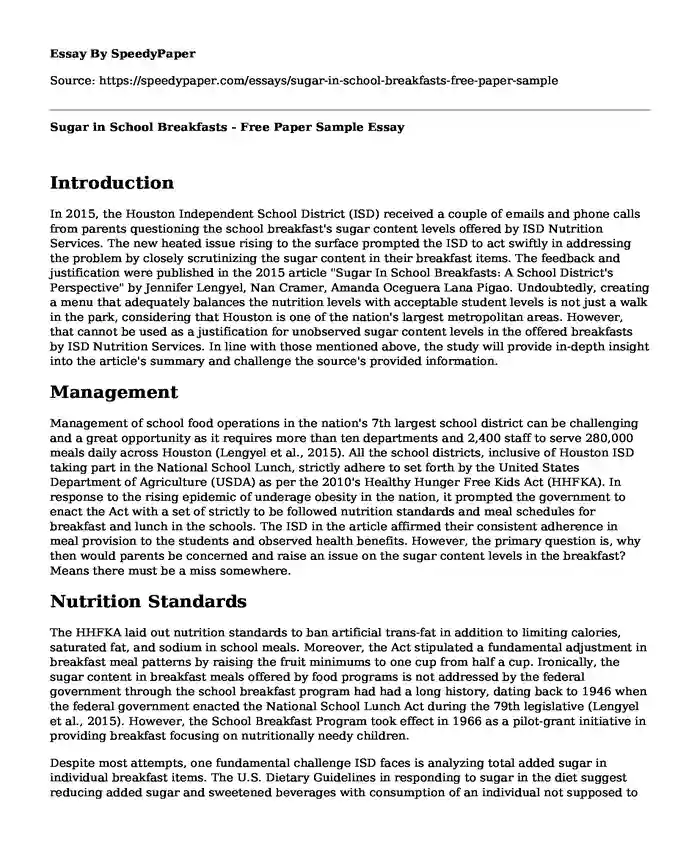Introduction
In 2015, the Houston Independent School District (ISD) received a couple of emails and phone calls from parents questioning the school breakfast's sugar content levels offered by ISD Nutrition Services. The new heated issue rising to the surface prompted the ISD to act swiftly in addressing the problem by closely scrutinizing the sugar content in their breakfast items. The feedback and justification were published in the 2015 article "Sugar In School Breakfasts: A School District's Perspective" by Jennifer Lengyel, Nan Cramer, Amanda Oceguera Lana Pigao. Undoubtedly, creating a menu that adequately balances the nutrition levels with acceptable student levels is not just a walk in the park, considering that Houston is one of the nation's largest metropolitan areas. However, that cannot be used as a justification for unobserved sugar content levels in the offered breakfasts by ISD Nutrition Services. In line with those mentioned above, the study will provide in-depth insight into the article's summary and challenge the source's provided information.
Management
Management of school food operations in the nation's 7th largest school district can be challenging and a great opportunity as it requires more than ten departments and 2,400 staff to serve 280,000 meals daily across Houston (Lengyel et al., 2015). All the school districts, inclusive of Houston ISD taking part in the National School Lunch, strictly adhere to set forth by the United States Department of Agriculture (USDA) as per the 2010's Healthy Hunger Free Kids Act (HHFKA). In response to the rising epidemic of underage obesity in the nation, it prompted the government to enact the Act with a set of strictly to be followed nutrition standards and meal schedules for breakfast and lunch in the schools. The ISD in the article affirmed their consistent adherence in meal provision to the students and observed health benefits. However, the primary question is, why then would parents be concerned and raise an issue on the sugar content levels in the breakfast? Means there must be a miss somewhere.
Nutrition Standards
The HHFKA laid out nutrition standards to ban artificial trans-fat in addition to limiting calories, saturated fat, and sodium in school meals. Moreover, the Act stipulated a fundamental adjustment in breakfast meal patterns by raising the fruit minimums to one cup from half a cup. Ironically, the sugar content in breakfast meals offered by food programs is not addressed by the federal government through the school breakfast program had had a long history, dating back to 1946 when the federal government enacted the National School Lunch Act during the 79th legislative (Lengyel et al., 2015). However, the School Breakfast Program took effect in 1966 as a pilot-grant initiative in providing breakfast focusing on nutritionally needy children.
Despite most attempts, one fundamental challenge ISD faces is analyzing total added sugar in individual breakfast items. The U.S. Dietary Guidelines in responding to sugar in the diet suggest reducing added sugar and sweetened beverages with consumption of an individual not supposed to exceed 10% of calories from added sugar (Cullen & Chen, 2017). However, the guidelines do not precisely quantify the recommended sugar amounts daily, which might cause the unwatched sugar content. The guidelines, however, note that reducing the added sugars can minimize calories while at the same time still watching the nutritional diet quality levels. Despite various hurdles, Houston ISD Nutrition Services has tried to lower added sugars while concurrently operating an initiative within budget limitations and items in the menu the students can consume.
Conclusion
Part of the Houston ISD defense recommends that if the public and parents feel the need for reduced sugar content in breakfast meals, then it would be necessary to seek policy adjustments at the federal level (Lengyel et al., 2015). Though there is a loophole in the dietary guidelines in quantifying the recommended sugar amounts in the school breakfast per day, it is up to the ISD Nutrition Services to liaise with the manufactures in finding a solution in the removal of unnecessary additives such as Mono Sodium Glutamate. Therefore, since ISD published a detailed and defensive article to some extent, it should, by all means, watch on the added sugars proportions in ensuring the sugar contents in the school breakfasts promote children's health benefits.
References
Cullen, K. W., & Chen, T. A. (2017). The contribution of the USDA school breakfast and lunch program meals to student daily dietary intake. Preventive medicine reports, 5, 82-85.
Lengyel, M. S., Jennifer, G., Cramer, R. D. N., LD, N., Oceguera, M. S., & Pigao MA, L. (2015). Sugar In School Breakfasts: A School District's Perspective. Journal of Applied Research on Children: Informing Policy for Children at Risk, 6(2), 7.
Cite this page
Sugar in School Breakfasts - Free Paper Sample. (2023, Nov 26). Retrieved from https://speedypaper.net/essays/sugar-in-school-breakfasts-free-paper-sample
Request Removal
If you are the original author of this essay and no longer wish to have it published on the SpeedyPaper website, please click below to request its removal:
- Essay Example on Groups of Pharmacological Treatments
- Nutrition Essay Example from Our Collection
- Essay Sample on Socratic Dialogue
- Essay Sample on Human Diseases by System: Skeletal and Muscular
- Ethical Priority-Setting in Healthcare during Pandemics: A Comprehensive Analysis and Policy Proposal - Free Essay
- Nurturing Minds and Cultures: The Crucial Roles of Universities in Alberta - Paper Example
- Essay Sample on Coronavirus Cases
Popular categories





